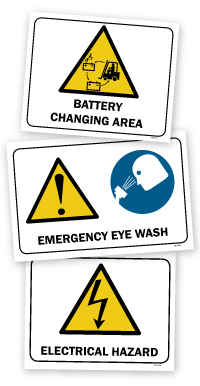We use cookies to make your experience better. To comply with the new e-Privacy directive, we need to ask for your consent to set the cookies. Learn more.
Using Signs and Labels to Improve Battery Room Safety
Safety is the most important factor in every battery room, and many of the potential hazards of battery change-outs can be mitigated with a decidedly low-tech solution: signage. Clear, discernable signs can prevent workplace accidents by pointing out hazardous areas and marking vital safety equipment for quick access.
It’s important to note that battery rooms are extremely safe when properly designed and outfitted; notwithstanding that, managers need to take appropriate actions to prevent accidents and to keep personnel informed. To understand the role of signage in the accident-free battery room, it's helpful to start by considering some of the general principles of workplace safety. The authors of the first chapter of Warnings and Risk Communication (1999) advocate three hierarchical lines of defense against accident or injury:
-
The strongest defense is prevention. Areas should be designed so that personnel don’t have to take any unnecessary risks.
-
If you can't eliminate the source of danger, try to guard against the hazard, either procedurally or with actual physical barriers.
-
When circumstances won't allow for either of these options, make sure that personnel are informed regarding potential dangers. Make sure that hazards are clearly marked, and that employees understand and respect the risks. This is where battery room signage is valuable.
The most effective safety signs incorporate iconic graphics with bold, clear text, which ensures that employees understand the hazards as soon as they see the images. Personnel need to be familiar with battery room signage in order to interpret the symbolic language, and familiarity with signs has been shown to contribute dramatically to overall safety. The International Organization for Standardization recommends successful recognition rates of 67 percent for all traffic safety signs; the American National Standards Institute calls for 85 percent recognition based on comprehension tests.
Appropriate signage in the battery room contributes to safety in the following ways:
-
Signs inform employees to use safe behaviors in a specific scenario, and can even remind staff of the appropriate procedures for any common work task. Graphics can be especially helpful.
-
When accidents occur in the battery room, a quick response can make a difference. If employees don’t need to look for emergency equipment, response times will be much faster; clearly labeled safety equipment is easier to find and access. Signs allow staff to instantly identify crucial gear so they can quickly respond to the situation.
Immediate action is particularly important when injuries are caused by exposure to corrosive substances, as trade publication Industrial Safety & Hygiene News reports. The first few seconds of exposure are critical for reducing the severity of corrosive injuries.
-
Many federal and state regulations require specific signs in battery rooms. Of course, industrial codes and regulations differ from state to state and nation to nation, and only a legal expert can tell you exactly which codes to consider for your facility. For a general view of the requirements, here are a few common regulations that specify appropriate signage for battery charging and changing areas:
-
Article 52.3.8 of the National Fire Protection Agency Fire Code (NFPA 1) requires signs for accessways into any area that contains storage batteries, as well as battery cabinets and related chemical, electrical, and fire hazards.
-
The NFPA electrical safety standards, NFPA 70E, also require signs in battery charging areas. Article 320.3.5 of NFPA 70E mandates warning signs for electrical and chemical hazards within the battery room.
Moreover, Article 205.10 requires warning signs to be visible and securely attached, and Article 205.11 requires that circuits and voltage be appropriately identified in a secure, legible manner.
-
The International Fire Code (IFC) contains signage requirements similar to those found in the NFPA Fire Code. Article 608.7 of the IFC requires clear labels for stationary battery rooms and cabinets.
-
More generally, the OSHA standard 29 CFR 1926.200 differentiates between “danger” signs, which concern immediate hazards, and “caution” signs, which address potentially unsafe situations or practices.
-
To view an ideal collection of signs and labels that help comply with these codes, check out the BHS Signage & Posting Kit, which was designed specifically for battery room applications.
References:
Eckhardt, Bob. "Sorting Out Battery Handling Regulations." Concrete Products 103.7 (2000): 96. Business Source Premier. Web. 28 May 2015.
Hsu, Tzu Fan, and Pin Chang Lin. "Graphical Symbols: The Effects Of Proximate Context And Educational Background On Recognition Performance." Information Design Journal (IDJ) 19.1 (2011): 18-27. Communication & Mass Media Complete. Web. 28 May 2015.
Ferraro, Christina N. Traffic Safety. Hauppauge, N.Y.: Nova Science Publishers, 2011. eBook Collection (EBSCOhost). Web. 28 May 2015.
"NFPA 1: Fire Code." NFPA 1: Fire Code. National Fire Protection Association, n.d. Web. 01 June 2015.
"NFPA 70E: Standard for Electrical Safety in the Workplace®." NFPA 70E: Standard for Electrical Safety in the Workplace®. National Fire Protection Association, n.d. Web. 01 June 2015.
Smart, Sally. "Access Is Everything." Industrial Safety & Hygiene News (2015): 50. Business Source Premier. Web. 1 June 2015.
Occupational Safety and Health Administration. “Accident Prevention Signs and Tags - 1926.200.” U.S. Department of Labor, Occupational Safety and Health Administration. OSHA, n.d.Web. 27 May 2014.
Wogalter, Michael S., David M. DeJoy, and Kenneth R. Laughery. Warnings And Risk Communication. London: CRC Press, 1999. eBook Collection (EBSCOhost). Web. 28 May 2015.

